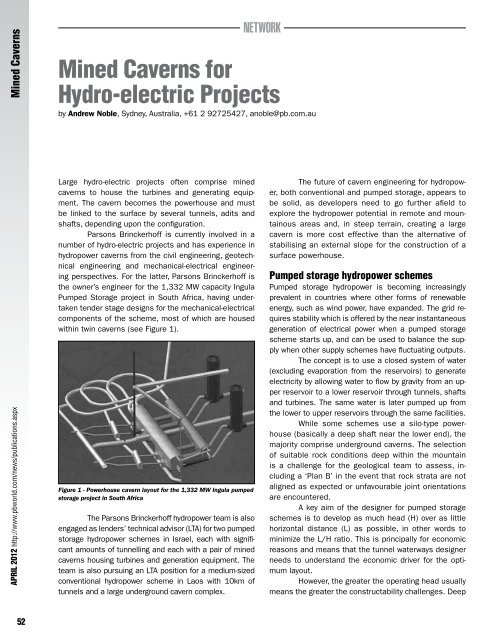Mining & Mined Caverns - Parsons Brinckerhoff
Mining & Mined Caverns - Parsons Brinckerhoff
Mining & Mined Caverns - Parsons Brinckerhoff
You also want an ePaper? Increase the reach of your titles
YUMPU automatically turns print PDFs into web optimized ePapers that Google loves.
<strong>Mined</strong> <strong>Caverns</strong><br />
APRIL 2012 http://www.pbworld.com/news/publications.aspx<br />
52<br />
Large hydro-electric projects often comprise mined<br />
caverns to house the turbines and generating equipment.<br />
The cavern becomes the powerhouse and must<br />
be linked to the surface by several tunnels, adits and<br />
shafts, depending upon the configuration.<br />
<strong>Parsons</strong> <strong>Brinckerhoff</strong> is currently involved in a<br />
number of hydro-electric projects and has experience in<br />
hydropower caverns from the civil engineering, geotechnical<br />
engineering and mechanical-electrical engineering<br />
perspectives. For the latter, <strong>Parsons</strong> <strong>Brinckerhoff</strong> is<br />
the owner’s engineer for the 1,332 MW capacity Ingula<br />
Pumped Storage project in South Africa, having undertaken<br />
tender stage designs for the mechanical-electrical<br />
components of the scheme, most of which are housed<br />
within twin caverns (see Figure 1).<br />
The <strong>Parsons</strong> <strong>Brinckerhoff</strong> hydropower team is also<br />
engaged as lenders’ technical advisor (LTA) for two pumped<br />
storage hydropower schemes in Israel, each with significant<br />
amounts of tunnelling and each with a pair of mined<br />
caverns housing turbines and generation equipment. The<br />
team is also pursuing an LTA position for a medium-sized<br />
conventional hydropower scheme in Laos with 10km of<br />
tunnels and a large underground cavern complex.<br />
Network<br />
<strong>Mined</strong> <strong>Caverns</strong> for<br />
Hydro-electric Projects<br />
by Andrew Noble, Sydney, Australia, +61 2 92725427, anoble@pb.com.au<br />
Figure 1 - Powerhouse cavern layout for the 1,332 MW Ingula pumped<br />
storage project in South Africa<br />
The future of cavern engineering for hydropower,<br />
both conventional and pumped storage, appears to<br />
be solid, as developers need to go further afield to<br />
explore the hydropower potential in remote and mountainous<br />
areas and, in steep terrain, creating a large<br />
cavern is more cost effective than the alternative of<br />
stabilising an external slope for the construction of a<br />
surface powerhouse.<br />
Pumped storage hydropower schemes<br />
Pumped storage hydropower is becoming increasingly<br />
prevalent in countries where other forms of renewable<br />
energy, such as wind power, have expanded. The grid requires<br />
stability which is offered by the near instantaneous<br />
generation of electrical power when a pumped storage<br />
scheme starts up, and can be used to balance the supply<br />
when other supply schemes have fluctuating outputs.<br />
The concept is to use a closed system of water<br />
(excluding evaporation from the reservoirs) to generate<br />
electricity by allowing water to flow by gravity from an upper<br />
reservoir to a lower reservoir through tunnels, shafts<br />
and turbines. The same water is later pumped up from<br />
the lower to upper reservoirs through the same facilities.<br />
While some schemes use a silo-type powerhouse<br />
(basically a deep shaft near the lower end), the<br />
majority comprise underground caverns. The selection<br />
of suitable rock conditions deep within the mountain<br />
is a challenge for the geological team to assess, including<br />
a ‘Plan B’ in the event that rock strata are not<br />
aligned as expected or unfavourable joint orientations<br />
are encountered.<br />
A key aim of the designer for pumped storage<br />
schemes is to develop as much head (H) over as little<br />
horizontal distance (L) as possible, in other words to<br />
minimize the L/H ratio. This is principally for economic<br />
reasons and means that the tunnel waterways designer<br />
needs to understand the economic driver for the optimum<br />
layout.<br />
However, the greater the operating head usually<br />
means the greater the constructability challenges. Deep

















